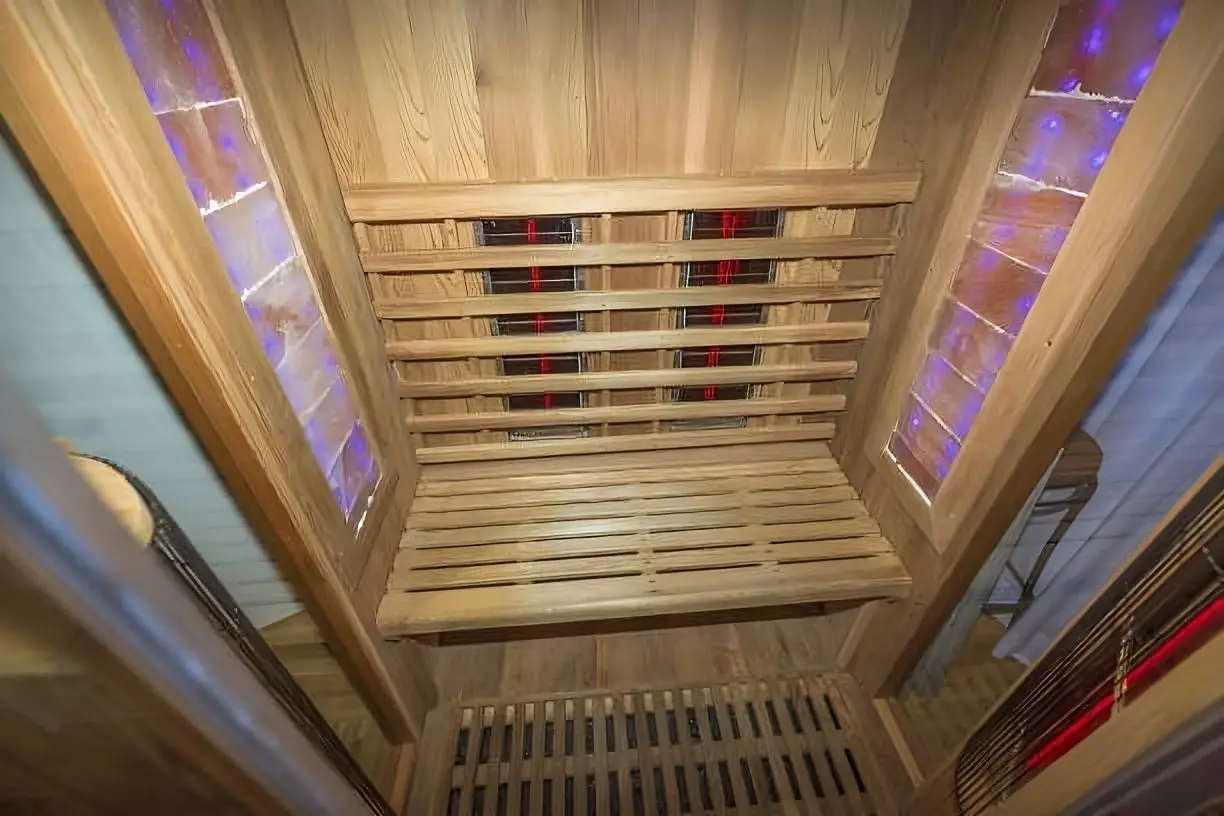Infrared Saunas
A traditional infrared sauna is a type of sauna that uses infrared radiation to heat the body directly. Infrared radiation is a form of energy that is emitted by the sun and other heat sources, and it is capable of penetrating the skin and heating the tissues directly.
In a traditional infrared sauna, infrared heating panels are used to emit infrared radiation at a specific wavelength, typically in the far infrared range. These panels are usually made of materials like carbon fiber or ceramic and are positioned throughout the sauna to ensure even heat distribution.
When a person enters the sauna, the infrared radiation penetrates the body’s tissues and causes them to heat up. This leads to a number of health and wellness benefits, including increased circulation, relaxation of muscles, pain relief, and detoxification through sweating.
Traditional infrared saunas are typically designed for use in the home and are available in a variety of sizes and styles to fit different needs and preferences. They are often preferred over other types of saunas because they operate at lower temperatures than traditional steam saunas, making them more comfortable and accessible for people who may not be able to tolerate the high heat of a steam sauna.
Three Types of Infrared Saunas
Far Infrared Saunas: Far infrared saunas use heating elements that emit far infrared radiation, which has a longer wavelength and penetrates the body deeper than other types of infrared radiation. This allows for deeper heating and more effective detoxification. Far infrared saunas typically operate at lower temperatures (around 120-140°F) and use less electricity than other types of saunas.
Near Infrared Saunas: Near infrared saunas use heating elements that emit near infrared radiation, which has a shorter wavelength and does not penetrate the body as deeply as far infrared radiation. Near infrared saunas typically operate at higher temperatures (around 140-150°F) and may be more effective for improving skin health and promoting wound healing.
Full Spectrum Saunas: Full spectrum saunas use a combination of different types of heating elements to emit a range of infrared radiation wavelengths, including far, mid, and near infrared radiation. This provides a wider range of health benefits than traditional far infrared saunas, as each type of radiation has its own unique benefits. Full spectrum saunas typically operate at lower temperatures than traditional far infrared saunas (around 120-140°F) and are designed to provide a more comfortable and effective sauna experience.
Pros:
- Deep Tissue Heating: Infrared saunas penetrate deeper into the skin and tissues, producing a deep heating effect that can help to promote relaxation, increase blood flow, and improve overall health and wellness.
- Detoxification: Sweating in an infrared sauna can help to eliminate toxins from the body, promoting overall health and well-being.
- Reduced Risk of Overheating: Infrared saunas operate at lower temperatures than traditional saunas, reducing the risk of overheating or discomfort during use.
- Comfortable Experience: Infrared saunas emit a dry heat that can be more comfortable and easier to tolerate than the high humidity of traditional steam saunas.
- Energy Efficient: Infrared saunas use less energy than traditional saunas, making them more environmentally friendly and cost-effective to operate.
Cons:
- Limited Research: While there is some evidence to support the benefits of infrared sauna therapy, there is limited research on the long-term effects of regular use.
- Potential for Dehydration: Sweating in an infrared sauna can lead to dehydration, which can be harmful to some individuals. It is important to drink plenty of water before and after using the sauna to prevent dehydration.
- Not Suitable for Everyone: Infrared saunas may not be suitable for individuals with certain medical conditions, such as high blood pressure, heart disease, or certain skin conditions. It is important to consult a healthcare provider before using an infrared sauna.
- Limited Range of Motion: Some individuals may find it difficult to move around or stretch in the small, enclosed space of an infrared sauna, which can limit the range of motion during use.
- Expensive: Infrared saunas can be more expensive than traditional saunas, especially for high-end models with advanced features or larger sizes.
Award Winning Products
Order Online
Transform your home into a luxurious wellness retreat with our Full Spectrum Saunas, designed to promote relaxation, detoxification, and healing. Our saunas are easy to order online and come with customizable settings, energy-efficient technology, and reliable shipping to ensure that you receive the ultimate sauna experience in the comfort of your own home. So why wait? Invest in your health and wellness today with our Full Spectrum Saunas!




